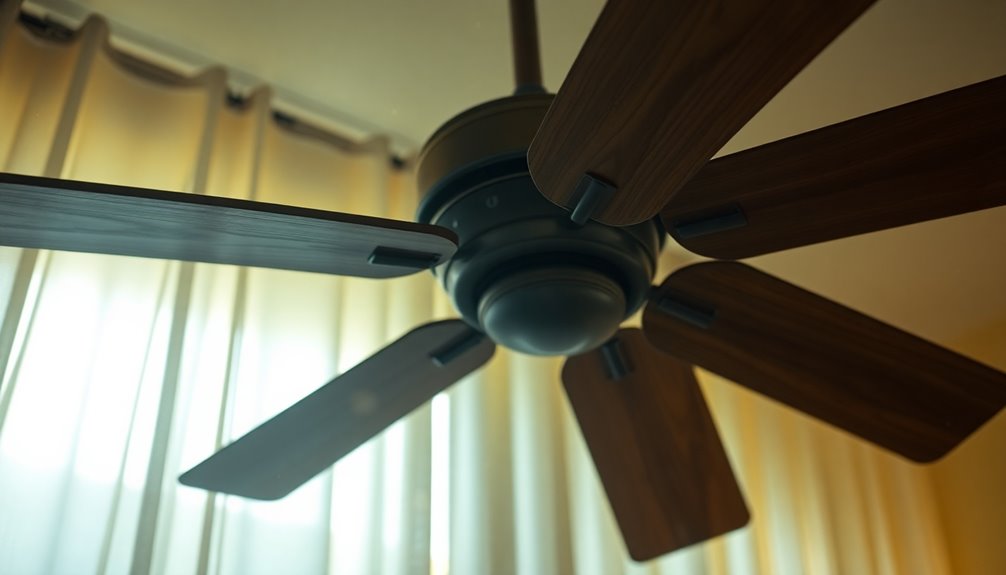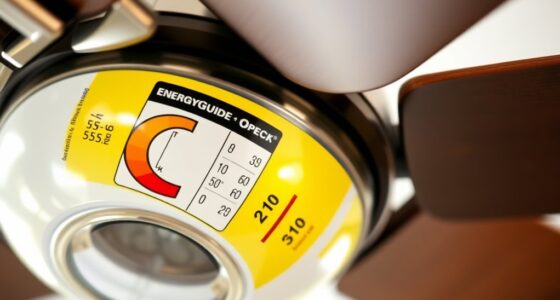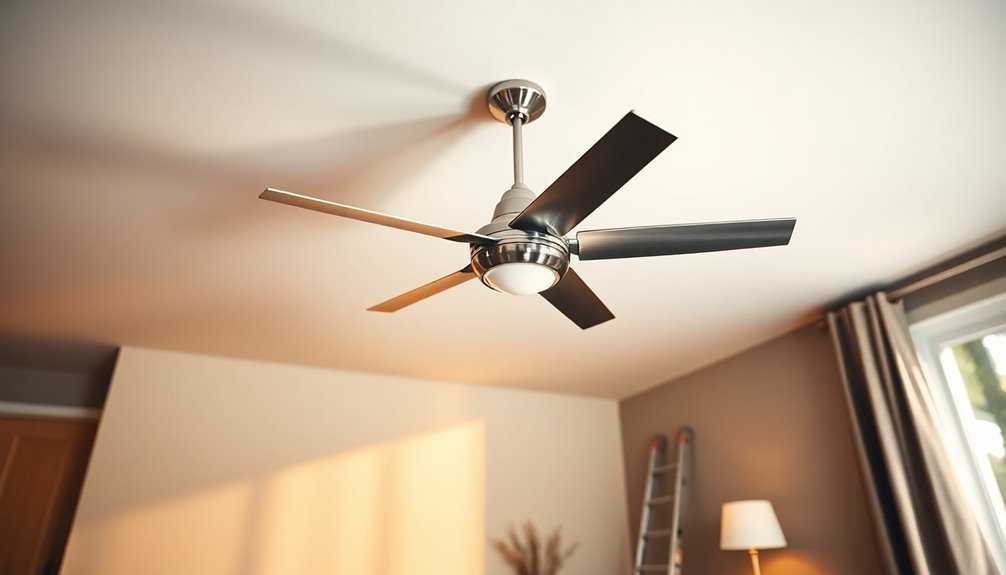If your ceiling fan's running slow, it could be due to several factors. Dust buildup on the blades can create drag, while worn motor bearings might prevent smooth rotation. A faulty motor capacitor, which regulates power, often affects speed too. You might also have loose electrical connections or unbalanced blades slowing it down. Regular cleaning and maintenance can greatly improve performance. If these tips don't solve the issue, you may need to explore other potential problems that can impact your fan's effectiveness. There's more to uncover about keeping your fan in top shape.
Key Takeaways
- A faulty motor capacitor can restrict power, leading to sluggish performance; replacement may be needed every 3-4 years.
- Dust accumulation on blades creates drag, significantly reducing airflow and efficiency; regular cleaning is essential.
- Worn motor bearings or misalignment can hinder smooth rotation, causing the fan to operate slowly.
- Loose electrical connections may prevent adequate power supply, affecting the fan's speed settings.
- Regular maintenance, including lubrication and blade balancing, is crucial for optimal performance and speed.
Symptoms of Slow Ceiling Fan
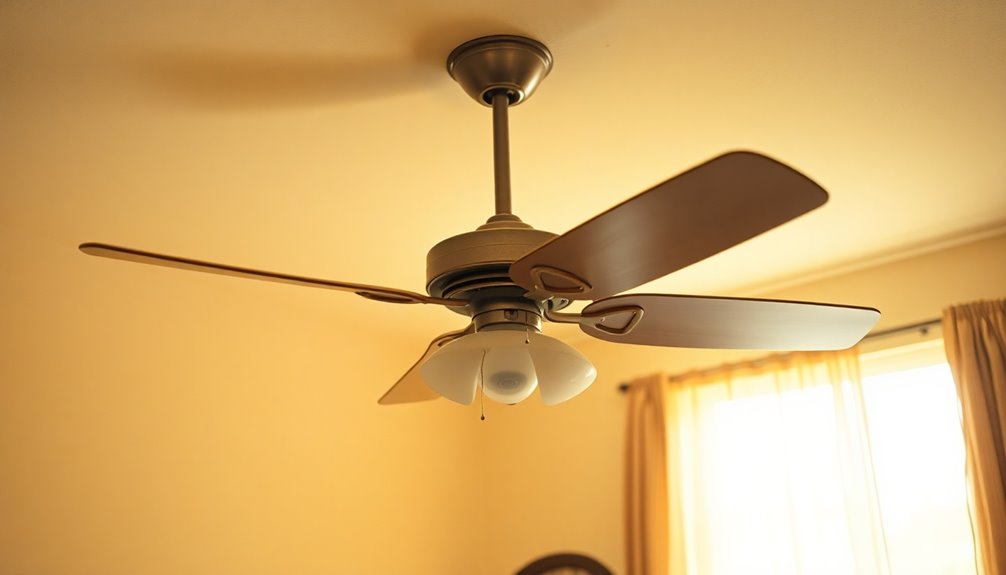
When your ceiling fan starts to feel sluggish, it's a clear sign something's off. You might notice that the highest setting barely produces a breeze, feeling more like the middle setting. This change is one of the key symptoms of slow speed.
Another sign to watch for is any unusual noise, like humming, grinding, or buzzing. These sounds often indicate issues with the mechanical components inside your fan, which could be affecting its performance.
To pinpoint the problem, it's crucial to check the fan regularly. Look for dust accumulation on the blades, as this can create drag and hinder rotation efficiency. If you ignore this buildup, it may lead to a more significant reduction in speed over time.
Additionally, consider inspecting the motor bearings; worn bearings can prevent smooth rotation, further slowing down the fan.
Common Causes of Reduced Speed

Reduced ceiling fan speed can stem from several common issues that impact its performance. One major culprit is a faulty motor capacitor, which is vital for regulating power to the fan motor. If it's gone bad, you might need to replace it every 3-4 years to keep your fan running efficiently.
Another issue is the accumulation of dirt on the blades. Dust and grime can create drag, making it harder for your fan to rotate properly.
Similarly, damaged or unbalanced blades can lead to wobbling, which not only slows your fan down but may also strain the motor, leading to further motor problems.
You should also check for loose electrical connections or wiring. Inadequate power supply can slow the fan across all speed settings.
Finally, mechanical issues like worn bearings or misaligned components can hinder rotation, reducing overall speed performance.
To keep your ceiling fan running smoothly, confirm proper installation and regular maintenance. Addressing these common causes swiftly can improve your fan's efficiency and prolong its lifespan.
Troubleshooting Your Ceiling Fan
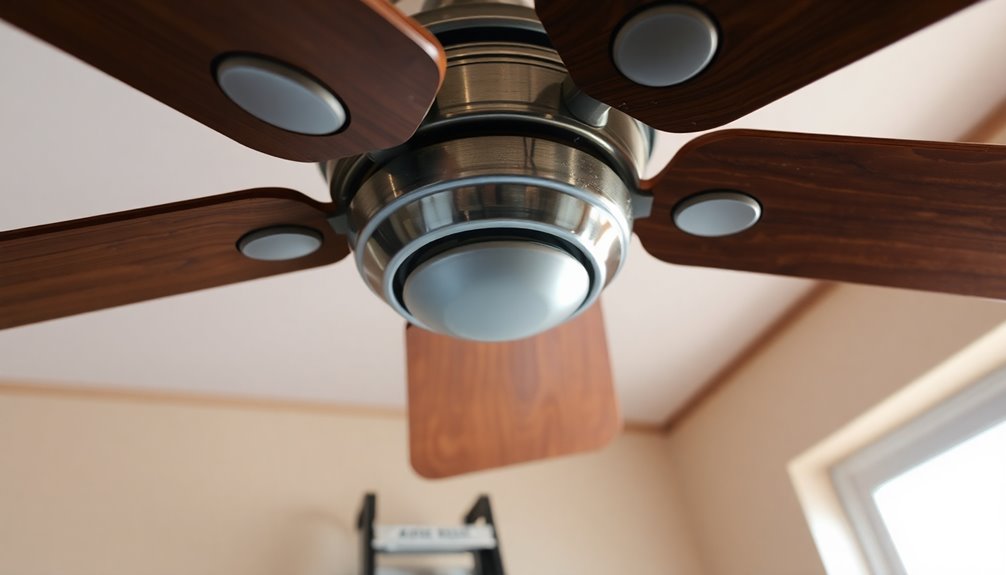
Troubleshooting your ceiling fan involves a systematic approach to identifying and resolving the issues that cause it to run slowly.
Start by inspecting the fan blades; dust accumulation can create drag, reducing the RPM. Regular cleaning can markedly improve speed and efficiency.
Next, check for mechanical issues. Worn bearings or misaligned blades can hinder performance, so verify everything is properly aligned and functioning smoothly.
Test your fan at different speed settings. This can help you determine if the problem lies with the speed controller or the electrical connections. Inspect these components for wear or damage, as faulty wiring can lead to inadequate power supply, resulting in reduced fan speed.
Don't overlook the motor capacitor, either. If your fan is around 3-4 years old and running slowly, it might be time to replace this vital component.
Finally, make certain the installation is secure. Loose connections can cause issues as well, so double-check all wiring.
Repair Options for Slow Fans
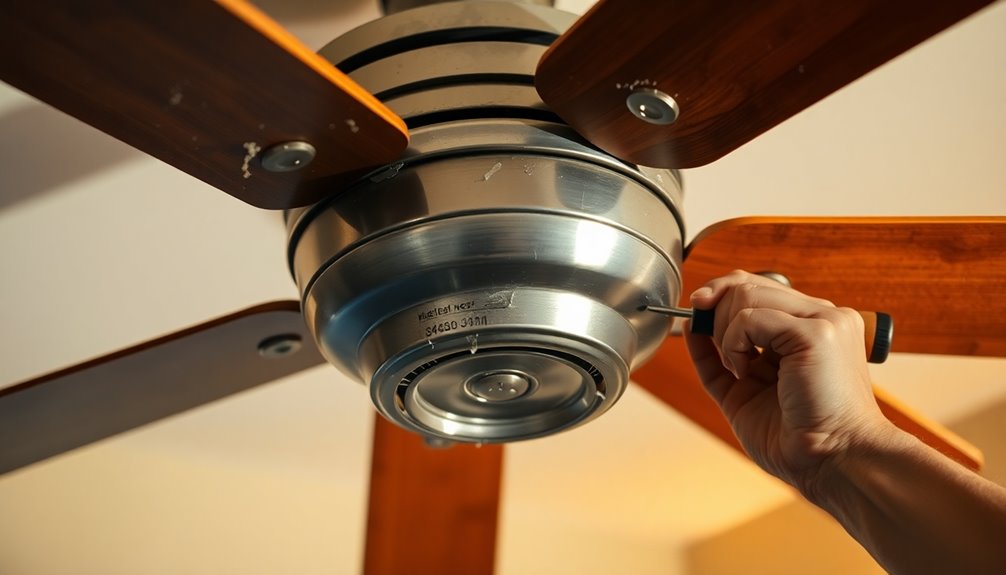
If your ceiling fan is running slow, there are several repair options you can explore to restore its speed.
Start by checking the motor capacitor, cleaning the blades, and lubricating the motor for better performance. Regular maintenance, including monthly cleaning of pre-filters, can make a significant difference in how effectively your fan operates.
Capacitor Replacement Steps
When your ceiling fan's performance dips, it could be due to a faulty capacitor, and replacing it can restore its speed.
Start by making sure the fan is turned off and disconnected from the power source to prevent any electrical shock. Next, locate the capacitor, usually found in the fan's housing near the motor. Before removing it, take note of the wiring connections and the capacitor specifications.
Use a multimeter to test the capacitor for continuity. If you don't find continuity, it's time to replace it, which typically costs between $5.00 and $12.00.
Carefully disconnect the old capacitor, making sure to remember the wire colors and positions for the new installation.
Once you've got the new capacitor, install it by reversing the removal process. Make certain all connections are secure to avoid further issues.
After replacing the capacitor, reassemble the fan, restore power, and test it out. You should notice an improvement in speed and efficiency.
Blade Cleaning Techniques
After replacing the capacitor, it's important to take into account other factors that might be slowing down your ceiling fan. One of the simplest yet most effective methods is using proper blade cleaning techniques. Regularly cleaning fan blades can greatly reduce dust accumulation, which often causes increased drag and lowers performance.
Here are some effective cleaning methods:
| Technique | Tools Needed | Frequency |
|---|---|---|
| Damp Cloth Method | Damp cloth or pillowcase | Every few months |
| Mild Detergent Method | Mild detergent and water mix | As needed |
| Full Fan Clean | Ladder, soft brush, cloth | Monthly |
When cleaning fan blades, always wipe both the top and bottom surfaces to prevent dust buildup. Use a mild detergent mixed with water to tackle stubborn grime while protecting the blade finish. Remember to avoid bending the blades during cleaning, as misalignments can further reduce airflow and speed efficiency. By maintaining clean blades, you can help guarantee your ceiling fan operates at its best.
Motor Lubrication Tips
To keep your ceiling fan running smoothly and efficiently, regular motor lubrication is crucial. Properly lubricated motors reduce friction, greatly improving your fan's operational speed.
Here are some tips to guarantee your fan stays in top shape:
- Choose the Right Oil: Use lightweight machine oil or a specialized fan lubricant. Always apply it according to the manufacturer's guidelines.
- Lubricate Annually: Aim to lubricate your fan at least once a year. This helps maintain peak speed and reduces wear on motor components.
- Listen for Noises: If your fan is making unusual sounds, like grinding or humming, it's a sign that lubrication is needed. Dry bearings can lead to these annoying noises during operation.
- Clean Before Lubricating: Before you apply oil, make sure to clean any dust or debris from the fan. Buildup can impede movement and worsen slow speed issues.
Maintenance Tips for Ceiling Fans

Your ceiling fan's performance relies heavily on regular maintenance, so it's important to keep it in top shape. Start by regularly cleaning the blades with a damp cloth or a pillowcase. This prevents dust buildup, which can create drag and slow down your fan's speed without you even realizing it.
If you have an old fan, make sure you lubricate the motor and bearings at least once a year for smooth operation.
Next, inspect and tighten any loose screws or connections. Loose components can lead to decreased efficiency and wobbling, making your fan work harder than necessary.
Don't forget to check the fan's capacitor annually. A faulty capacitor is a common cause of slow fan speeds, but it can often be replaced easily if needed.
Finally, balance the fan blades by adjusting their angles and confirming they're free from damage. Misaligned or bent blades can greatly impact airflow and speed.
How to Improve Fan Performance

To boost your ceiling fan's performance, start by regularly cleaning the blades to remove dust buildup that can slow it down.
Next, check the capacitor's functionality, as a faulty capacitor can greatly impact the fan's speed.
Clean Fan Blades Regularly
Regular cleaning of your ceiling fan's blades is essential for maintaining peak performance and efficiency. Dust accumulation can create drag, slowing down the rotation and drastically reducing airflow.
In fact, dirt buildup can cut your fan's airflow efficiency by up to 30%. To keep your ceiling fan operating smoothly, follow these simple cleaning tips:
- Use a damp pillowcase: Wipe the blades with a damp pillowcase to catch dust particles effectively, preventing them from falling onto the floor.
- Schedule routine cleanings: Clean your fan every few months or more often in dusty environments to guarantee consistent airflow and speed.
- Check for obstructions: While cleaning, inspect for any items that may obstruct the fan's movement to maintain top performance.
- Extend motor lifespan: Regular cleaning not only improves speed but also reduces strain on the motor, extending its lifespan and the longevity of other components.
Check Capacitor Functionality
Cleaning fan blades can improve airflow, but if your ceiling fan is still slow, it might be time to check the capacitor functionality. The capacitor plays a vital role in regulating power to the motor, and a malfunctioning capacitor can greatly reduce ceiling fan speed.
If your fan's performance has dropped, inspecting the capacitor should be a priority, especially if it's been three to four years since its last replacement.
Look for symptoms like a noticeable decrease in speed across all settings or the fan only working on certain speeds. If you notice these issues, it's likely time to replace the fan capacitor. Replacement capacitors typically cost between $5.00 and $12.00, making this a cost-effective solution to restore your fan's performance.
When replacing a capacitor, verify that the new one matches the voltage and microfarad rating of the original. This compatibility is essential to prevent further issues.
Understanding Fan Speed Specifications
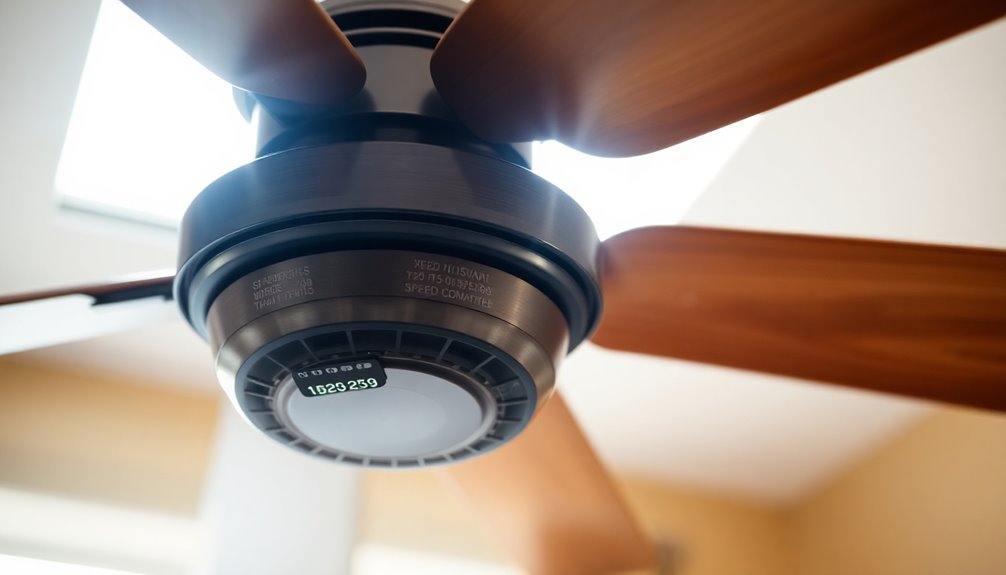
When choosing a ceiling fan, understanding fan speed specifications is essential for ensuring ideal air circulation in your space. Ceiling fan speed is typically measured in revolutions per minute (RPM), with average models spinning between 50 and 100 RPM.
However, high-speed fans can achieve an impressive 350 to 400 RPM, which greatly enhances airflow.
Here are four key points to evaluate when assessing ceiling fan speeds:
- Blade Size: Larger blades can move more air, impacting the overall RPM and cooling effect.
- Motor Type: AC motors usually offer standard speeds, while DC motors can provide higher RPM with lower power consumption.
- Blade Pitch: Steeper angles of blades can lead to increased airflow, resulting in better cooling efficiency.
- Manufacturer Variability: Always check product guidelines, as specifications can vary greatly between brands and models.
When to Seek Professional Help
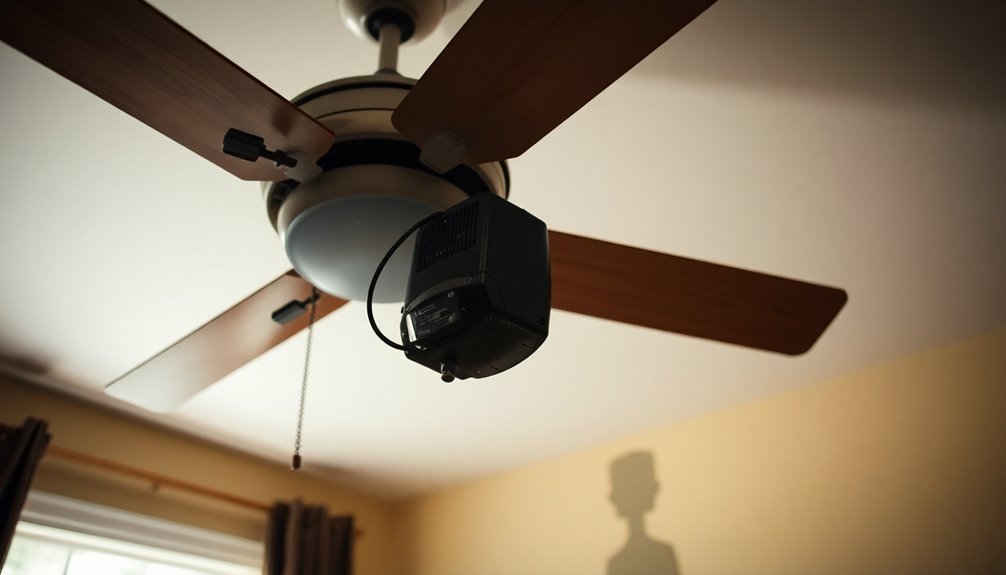
If your ceiling fan's speed remains consistently slow across all settings, it might be time to seek professional help. This issue could indicate deeper electrical or mechanical problems that require expert diagnosis.
If you notice visible damage or swelling on the motor capacitor, don't hesitate to reach out for professional assistance. A failing motor capacitor can lead to increased inefficiency and further complications.
Additionally, if your fan is making unusual noises, like grinding or buzzing, it's vital to consult an electrician. These sounds often signal potential motor or wiring issues that, if left unchecked, could escalate into more significant damage.
Moreover, if you find that your fan frequently overheats or struggles during high-speed operation, getting professional help is important to prevent further damage to the motor or electrical components.
Finally, if you're unsure about safely diagnosing or repairing any electrical components, it's always wise to enlist the expertise of a licensed electrician. Doing so not only promotes your safety but also guarantees compliance with safety standards.
Frequently Asked Questions
How Do You Fix a Slow Ceiling Fan?
To fix a slow ceiling fan, start by cleaning the blades with a damp cloth to eliminate dust.
Next, lubricate the motor and bearings using the right oil to minimize friction.
Check for faulty capacitors and replace them if needed, as they're essential for power.
Don't forget to inspect for loose screws or wiring connections; tightening these can enhance performance.
Finally, balance the blades to improve airflow and speed.
Why Is My Ceiling Fan Not Running at Full Speed?
Your ceiling fan should whirl like a dancer, but if it's not hitting full speed, something's off.
Dust might be dragging it down, so give those blades a good clean. Check for loose screws or damaged blades that can throw it off balance.
Electrical issues, like poor connections, could also be the culprit. Regular maintenance, like lubricating motor bearings, can help your fan find its rhythm again.
How Can I Make My Ceiling Fan Go Faster?
To make your ceiling fan go faster, start by cleaning the blades with a damp cloth to remove dust.
Next, lubricate the motor and bearings to reduce friction.
If you notice any faulty capacitors, replace them, as they regulate power and impact speed.
Confirm your speed controller matches your fan model, and regularly check for loose screws and balance in the blades to maintain peak performance.
Regular maintenance will keep your fan running efficiently.
Why Is My Fan Spinning so Slowly?
Your ceiling fan's like a tired horse plodding along, and it's not keeping up the pace you need.
If it's spinning slowly, check for dust buildup on the blades or motor. That grime can weigh down its performance.
Also, inspect for mechanical issues like worn bearings or loose wiring; they can zap the fan's energy.
A little cleaning and maintenance might just give it the boost to gallop again!
Conclusion
To sum up, if your ceiling fan's spinning slower than expected, you're not alone—about 30% of homeowners experience similar issues. By troubleshooting common causes and performing regular maintenance, you can often restore its performance. Remember, a well-functioning ceiling fan can reduce energy costs by up to 40% during hot months, making it worth the effort. If problems persist, don't hesitate to seek professional help. Your comfort and efficiency are just a few adjustments away!
